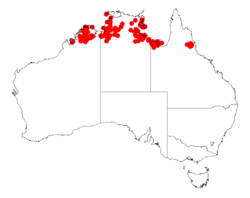Biology:Acacia nuperrima
| Acacia nuperrima | |
|---|---|
| Scientific classification | |
| Kingdom: | Plantae |
| Clade: | Tracheophytes |
| Clade: | Angiosperms |
| Clade: | Eudicots |
| Clade: | Rosids |
| Order: | Fabales |
| Family: | Fabaceae |
| Subfamily: | Caesalpinioideae |
| Clade: | Mimosoid clade |
| Genus: | Acacia |
| Species: | A. nuperrima
|
| Binomial name | |
| Acacia nuperrima Baker f.
| |

| |
| Occurrence data from AVH | |
Acacia nuperrima is a shrub of the genus Acacia and the subgenus Plurinerves that is endemic to a large area across northern Australia .
Description
The resinous shrub typically grows to a height of 1 to 3 metres (3 to 10 ft)[1] and has an erect ascending to semiprostrate and often spreading habit. It has multiple fine stems that branch near the base and has smooth grey to brown coloured bark and is slightly fissured toward the base. The branchlets have resin-crenulated ridges are finely lenticellate and are angled near the apices. Like most species of Acacia it has phyllodes rather than true leaves. The leathery, evergreen and rather spreading phyllodes have a narrowly elliptic or linear shape that are flat or occasionally a little undulate with a length of 0.4 to 3.5 cm (0.16 to 1.38 in) and a width of 1 to 5 mm (0.039 to 0.197 in) and have obscure nerves.[2] It blooms from January to October and produces yellow flowers.[1]
Distribution
It is native to an area in the Northern Territory and the Kimberley region of Western Australia where it is commonly situated along rivers and creeks, on ridges and plains and undulating country growing in sandy, sandy-clay or loamy or stony soils over and around sandstone or laterite.[1] In Western Australia it is common around Cape Londonderry, Derby and along the Fitzroy River. It is mostly found in the north-western and north-eastern parts of the Northern Territory including many islands in the Gulf of Carpentaria with the range extending into north-western Queensland to around the Corinda area as a part of woodland, shrubland, savannah woodland or sometimes open forest communities where it is usually associated with species of Eucalyptus or Melaleuca.[2]
See also
References
- ↑ Jump up to: 1.0 1.1 1.2 "Acacia nuperrima". FloraBase. Western Australian Government Department of Parks and Wildlife. https://florabase.dpaw.wa.gov.au/browse/profile/3462.
- ↑ Jump up to: 2.0 2.1 "Acacia nuperrima". World Wide Wattle. Western Australian Herbarium. http://worldwidewattle.com/speciesgallery/nuperrima.php?id=3462. Retrieved 21 December 2020.
Wikidata ☰ Q9567461 entry
 |

